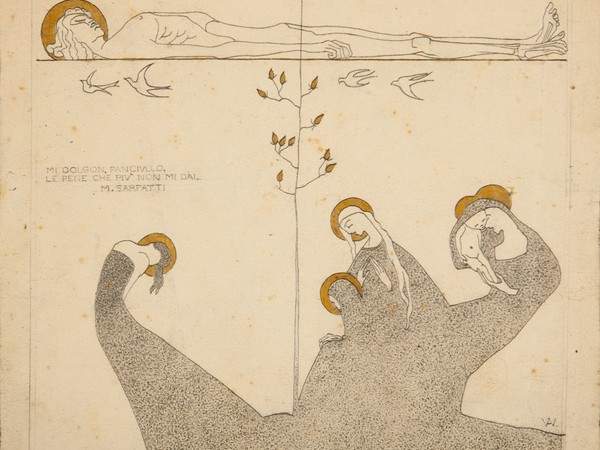Studio Guastalla Arte Moderna e Contemporanea presents a collection of works by Adolfo Wildt (about forty drawings including preparatory studies of monuments and scrolls with gold and some sculptures in marble and bronze) distilled over long years of research across generations until Jan. 31, 2023, at its Milan headquarters. Some have in fact been inherited by Ettore and Silvia Guastalla’s great-grandparents Belforte, who in 1922 opened Bottega d’Arte, one of the first Italian galleries, in Livorno, where they repeatedly exhibited works by Adolfo Wildt in group exhibitions and in a solo show in 1930. Accompanying the drawings that have remained in the family collection ever since, Studio Guastalla presents autograph letters from Adolfo and his son Francesco, who acted as his secretary, addressed at the time to Gino Belforte, concerning aesthetic and economic issues. Many other works have been collected over the years, mainly through direct contact with Wildt’s heirs, and some come from private individuals and art galleries.
Despite the coincidence of the opening of this exhibition, one hundred years after the opening of Bottega d’Arte, to celebrate a century of the family’s presence on the Italian art scene, the exhibition is intended to be a contemporary, non-antiquarian survey of the work of an artist faithful to an ideal of art as a search for the idea and not the content, for purity and not verisimilitude, for abstraction and not sentiment. Wildt speaks to us so urgently, one hundred years after his works were made, because his is a mental, abstract, and tremendously tormented art. Mario Sironi, his peer who in great diversity loved and understood him, wrote a beautiful obituary in 1931, on the occasion of the artist’s death, in "Il Popolo d’Italia,“ in which he captured the sense of his ”frantic aspiration toward that same fatal, splendid, impassive wonder" of the Baroque sculptors.
Rarely has a master been able to transmit to his students the deep core of his own worldview, leaving them then free to find their most authentic core as Wildt did with Lucio Fontana and Fausto Melotti, his disciples at theBrera Academy. But every time we look at our drawing of Christ Crucified we cannot help but think of a Fontana cut, with that sharp, diagonal, unhesitating mark. And in the drawing Mi dolgon fanciullo (in the image), dedicated to Margherita Sarfatti and her supreme sorrow, that of the death of a child, we glimpse, in that cross formed by two thin intersecting lines, the model of Melotti’s aerial constructions. Wildt’s art is timeless because it is emblematic, never accommodating, never easy. And that sharpness of truth cannot be imitated, only made one’s own and transformed into something equally sharp and true, by those who have the ability. Each with their own different way to show the pain of the world, naked, without veils, without hypocrisies.
The works include some important sculptures such as Fides, made by Wildt in marble in 1906 on commission from his Prussian patron Franz Rose, who supported him for years while directing him toward a Nordic and Central European gaze. The young man’s face has a crown of thorns and the astonished eyes turned upward of one who has entrusted his faith to heaven and wonders about the mystery of that Trust. The sculpture was made immediately before those three years of very severe depression that Wildt himself called “mental night” at the end of which, after obsessively sculpting and obsessively destroying, the artist emerged in his stylistic maturity. That crisis was followed by a period of “return” to classicism in part evidenced by Wildt’s 1918 portrait of little Augusto Solari as part of the Salvadenaio Exhibition, sponsored by Toscanini to stimulate Italian children to collect savings for war orphans. The winners were to receive a portrait by a famous artist of the time, and it fell to the child Augusto Solari to be portrayed in marble by Wildt, who made four examples of the sculpture. This one in the exhibition (from Wildt’s heirs and exhibited in 1930 at Bottega d’Arte on loan from Wildt himself), impeccable in its state of preservation, shows on the one hand the softening of those years in WIidt’s style compared to the dramatic of the earlier works, the clear reference to the fifteenth-century busts of Desiderio da Settignano, and at the same time the references to Art Nouveau phytomorphism in the volutes of the hair as well as that “exquisite finesse to the point of torture” noted by Margherita Sarfatti that gives the portrait a detached, glacial, funeral herma-like tone.
Among the many drawings, some already published in the 1920s and 1930s in the Bollettini di Bottega d’Arte, the monthly catalogs that the Livorno gallery produced to acquaint the public with its activities, also a sketch for a monument in which the curator, Mirko Agliardi, found the design for a funerary sculpture present at the Monumental Cemetery in Milan, hitherto unpublished, of which archival documents certify Wildtian authorship.
For all information, you can visit the official website of Studio Guastalla Arte Moderna e Contemporanea.
 |
| Milan, the intimate Adolfo Wildt on display at Studio Guastalla |
Warning: the translation into English of the original Italian article was created using automatic tools. We undertake to review all articles, but we do not guarantee the total absence of inaccuracies in the translation due to the program. You can find the original by clicking on the ITA button. If you find any mistake,please contact us.